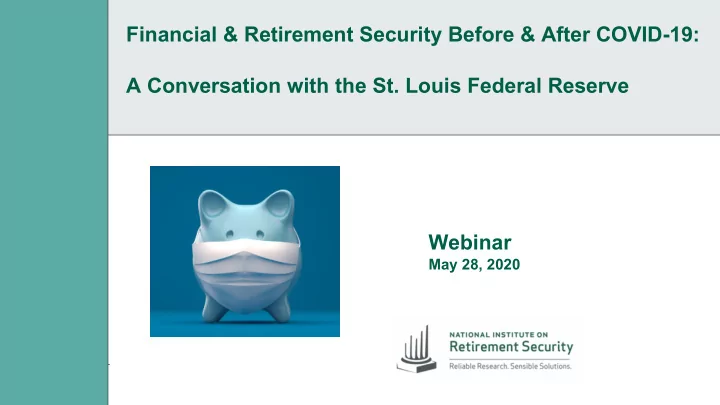

Financial & Retirement Security Before & After COVID-19: A Conversation with the St. Louis Federal Reserve Webinar May 28, 2020
Agenda Logistics & Speaker Introductions 1. Research Review 2. Q&A 3. 1
Logistics • Attendees in listen only mode. • Questions welcome. Type question using “Question” function on control panel, and we will answer. • Audio, technical issues during webinar, call GoToWebinar at 1-800-263-6317. • Webinar replay and slides will be posted at https://www.nirsonline.org/events. 2
Speakers Ray Boshara Dan Doonan Director of the Center for Household Financial Stability Executive Director Federal Reserve Bank of St. Louis National Institute on Retirement Security Lowell Ricketts Tyler Bond Lead Analyst for the Center for Household Financial Stability Research Manager Federal Reserve Bank of St. Louis National Institute on Retirement Security 3
Financial and Retirement Security Before and After COVID-19 National Institute on Retirement Security Webinar May 28, 2020 Ray Boshara, Senior Adviser and Director Lowell Ricketts, Lead Analyst *These are my own views, and not necessarily the views of the Federal Reserve Bank of St. Louis, Federal Reserve System, or the Board of Governors
Overview § Introduction § Retirement Security Before COVID-19 § Retirement Security After COVID-19 § Thoughts on Moving Forward 5
Introduction The Center for Household Financial Stability, a research initiative of the Federal § Reserve Bank of St. Louis, was launched in 2013 to address three questions: (1) What is the state of U.S. family wealth? (2) Why does wealth matter for both families and the economy? (3) What can we do to strengthen family balance sheets? The Center’s 1 st chapter has been defined by the Great Recession; our 2 nd is likely § to be defined by COVID-19—both cataclysmic economic events with profound impacts on family balance sheets in ways that, generally, exacerbate already existing inequalities of wealth. We examine retirement savings as one key component of family balance sheets, § with a particular focus on how three demographic drivers—age/birth year, race/ ethnicity, and education—predict retirement savings and family wealth. 6
R ETIREMENT S ECURITY B EFORE COVID-19 7
How Prepared are Americans for Retirement? § According to the 2019 SHED, only 37 percent of non-retired adults think their retirement savings plan is on track. § Furthermore, 25 percent of non-retired individuals reported that they had no retirement savings or pension whatsoever. § Among non-retired adults, only 22 percent have money in defined benefit pensions. § Of those aged 60 and older, 11.4 percent have no retirement savings or pension; 51 percent think their savings are on track. 8
Coverage Gap, Whites vs. Non-Whites Retirement Accounts, Households 55-64, Ownership Rate by Race/Ethnicity Ownership of defined § Percent 100 contribution (DC) plans White 90 has long differed between Nonwhite 80 white and nonwhite 68.6 66.0 70 families. 54.8 60 50 The gap was narrowest in § 40 44.5 1998 and has since 30 36.5 gradually expanded to 20 23.2 29.5 percentage points in 10 0 2016. 1989 1992 1995 1998 2001 2004 2007 2010 2013 2016 Source: Federal Reserve Board'sSurvey of Consumer Finances. 9
Funding Gaps, Whites vs. Non-Whites Retirement Accounts, 55-64, MedianValue by Race, Conditional on Ownership Of those families that own § Thousands of 2016 $ 180 DC plans , the typical White 154.8 160 white and nonwhite family Nonwhite 140 differs dramatically in 121.1 120 funding. 100 83.5 80 As of 2016, the typical § 60 white family had 2.6 times 47.4 66.7 59.8 40 the level of funding. 20 24.6 0 1989 1992 1995 1998 2001 2004 2007 2010 2013 2016 Source: Federal Reserve Board's Survey of Consumer Finances. 10
Coverage Varies by Race, Education, Income Ownership Rates for DC, DB, or IRA Retirement Accounts 100 No Yes 89.5 88.8 85.9 90 80 71.5 68.5 68.0 67.1 66.1 70 56.0 60 53.5 53.2 46.1 45.8 50 43.0 40 33.3 32.6 31.1 30.8 28.0 30 20 13.8 10.9 10.3 10 0 Source: Federal Reserve Board's 2019 SHED and Center for Household Financial Stability calculations. 11
Long-Term Savings Require Short-Term Stability § In 2019, 36% of adults would borrow, sell something, or not be able to cover a $400 expense. § This short-term financial insecurity precludes long-term savings: 10.1% of retirement account holders borrowed or cashed out funds in 2019. § Thus, improving retirement preparedness must proceed hand-in-hand with other efforts to improve financial well- being. 12
R ETIREMENT S ECURITY A FTER COVID-19 13
Employment Shock Varied Across Groups § From start of March to early April, 24.8% of non-retired , non- disabled adults lost a job, were furloughed, or lost hours. § Earning less : 34.5% of those earning less than $40,000. § Lacking a college degree : 27.5% lost jobs or hours. § White, non-Hispanic: 26.2% experienced disruption, although other racial and ethnic groups were similar. 14
Income Loss Short-Changes Retirement Security § The overall share that would borrow, sell something, or not be able to cover a $400 expense was similar (35%) . § However, among those that lost a job or had their hours significantly reduced, 54% would borrow, sell something, or not be able to cover the expense. § Lower-income and non-college educated individuals are least likely to currently have retirement accounts; weathering this crisis may delay investment in retirement security. 15
Moving Forward: Newer Ideas to Improve Retirement Security Pre-COVID Post-COVID Improve overall household All pre-COVID ideas, plus consider 1. financial stability, especially more ambitious proposals made managing cash and potentially possible by the pandemic: income/expense volatility Develop a more “wholistic” 1. Develop economic resilience, 2. approach to savings, reflecting especially through liquidity lived financial lives “buffers” such as emergency De-link retirement security and 2. savings employment Establish a “Roth at Birth” for 3. Re-imagine and broaden wealth- 3. every child in America building for the 21 st Century 16
C onnect With Us STLOUISFED.ORG/HFS Newsletter 17
Questions
Recommend
More recommend